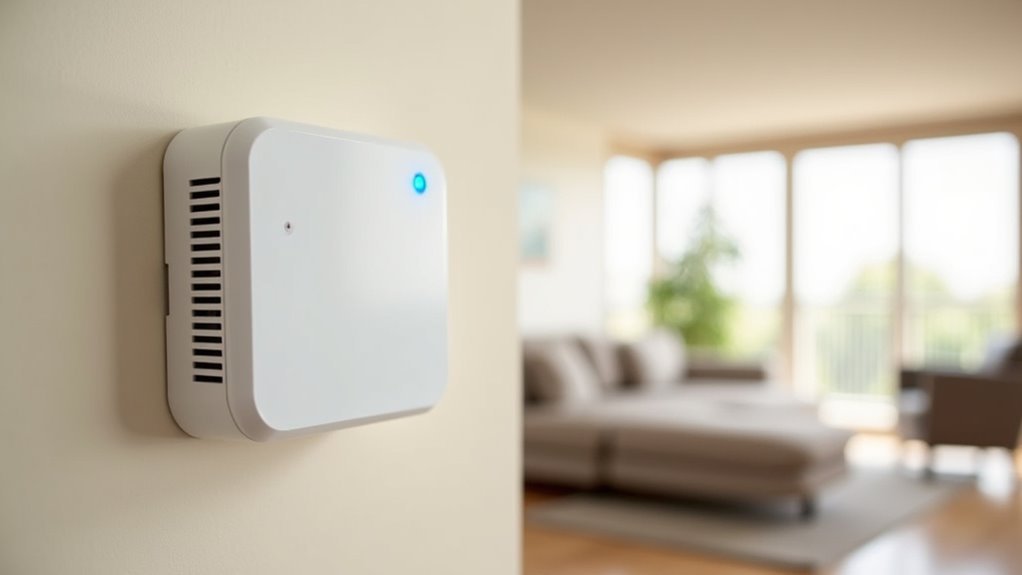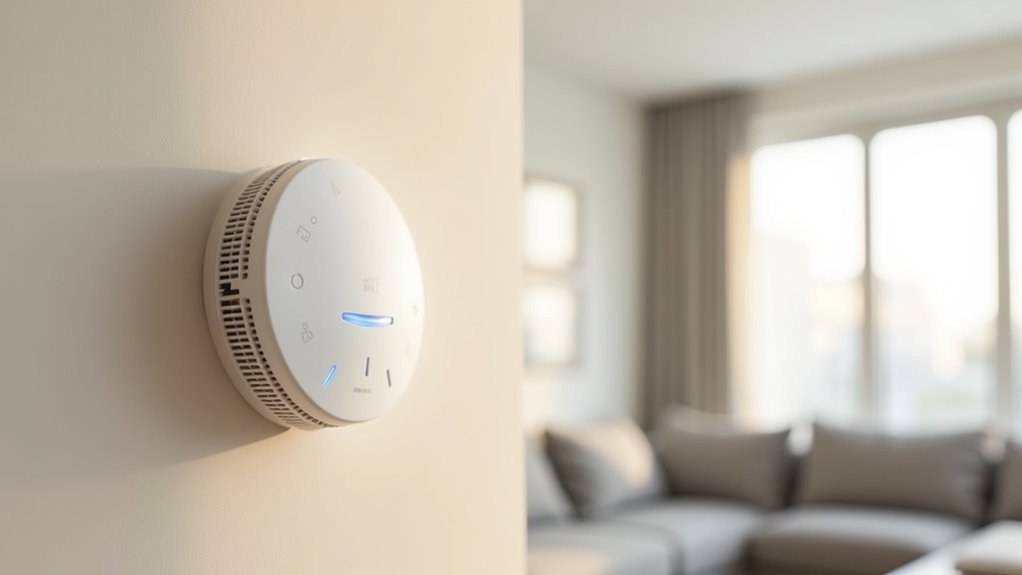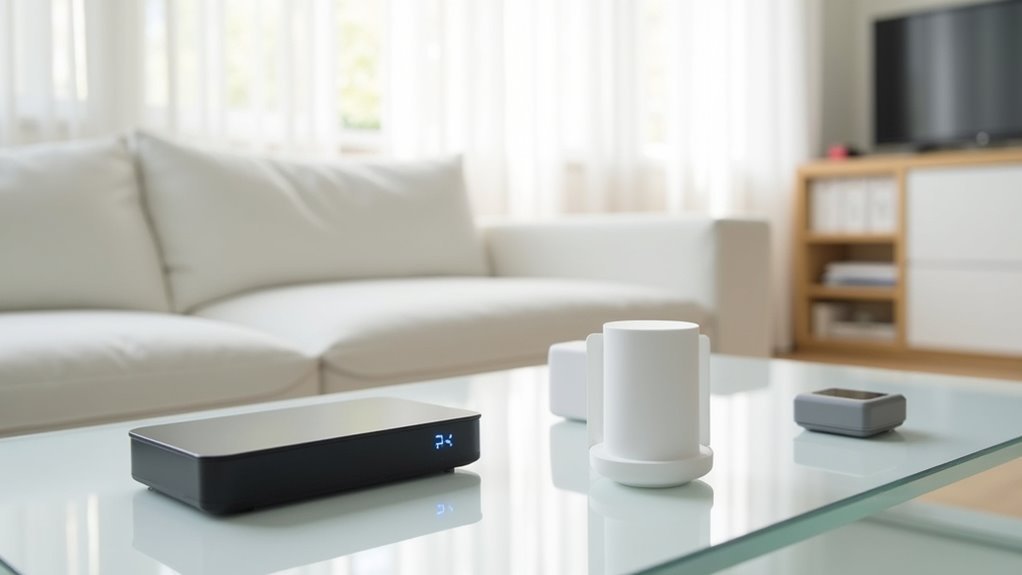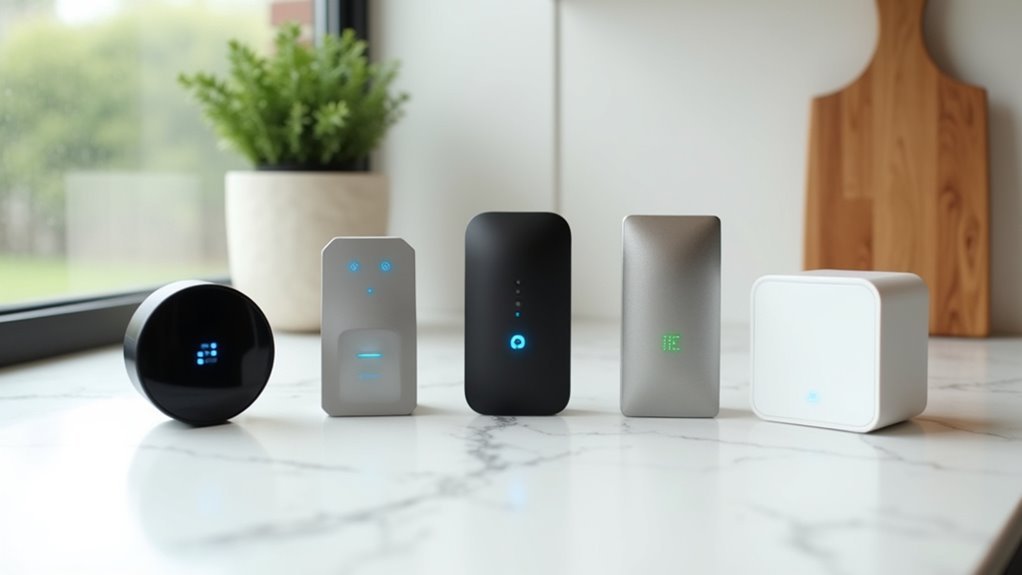You’re probably breathing polluted air right now without even knowing it. While your home might look clean, invisible threats like VOCs, particulate matter, and carbon monoxide could be lurking in every room. Zigbee air quality sensors offer an affordable solution to monitor these hidden dangers, but choosing the wrong one means you’ll miss critical pollutants that could affect your family’s health.
Understanding Zigbee Air Quality Sensors and Their Benefits

Millions of homes worldwide are embracing smart technology to monitor their indoor environments, and Zigbee air quality sensors represent one of the most effective solutions for tracking the air you breathe.
These devices excel at air quality monitoring by detecting various pollutants including CO2, VOCs, and particulate matter. Your indoor air quality monitor can also function as a temperature and humidity sensor, providing thorough environmental data.
Zigbee connectivity guarantees reliable performance within your smart home ecosystem while maintaining impressive battery life extending up to two years.
You’ll receive real-time alerts when air quality deteriorates, enabling immediate action. The automation capabilities let you trigger air purifiers or ventilation systems automatically, creating a healthier living environment without constant manual intervention.
Top-Rated Zigbee Air Quality Monitors for Smart Home Integration
Now that you understand the advantages of Zigbee air quality sensors, you’ll want to explore the specific models that deliver outstanding performance in real-world smart home environments.
The Heiman HS1CA-E stands out with its Figaro 5141 electrochemical sensor for carbon monoxide detection and built-in siren.
The Heiman HS1CA-E delivers professional-grade carbon monoxide detection with its advanced Figaro electrochemical sensor and integrated alarm system.
For thorough monitoring, the AirThings Wave Plus tracks radon, VOCs, Carbon Dioxide, temperature, and humidity levels through Bluetooth 5.0.
The Apollo AIR-1 excels at measuring particulate matter across multiple micron sizes with seamless Zigbee connectivity.
Aqara’s Air Quality Sensors monitor temperature, humidity, and PM levels, requiring a hub for smart home integration.
These monitors transform your home’s air quality management through reliable VOC sensor technology and automated responses.
Key Features to Consider When Choosing Zigbee Air Quality Sensors

When selecting the ideal Zigbee air quality sensor for your smart home, you’ll need to evaluate several critical features that directly impact performance and usability.
Your sensor should monitor multiple pollutants for thorough coverage:
- Particulate matter (PM2.5) – Essential for detecting fine particles that affect respiratory health
- VOCs detection – Monitors volatile organic compounds from household products and materials
- CO2 sensor capability – Tracks indoor air freshness and ventilation needs
- Carbon monoxide monitoring – Critical safety feature for detecting dangerous gas levels
Look for real-time data reporting with instant alerts when air quality deteriorates. The AirThings View Plus exemplifies these capabilities with its compact design and seamless integration.
Prioritize devices offering firmware updates to maintain accuracy and compatibility. Battery life, user-friendly interfaces, and reliable manufacturer support guarantee long-term satisfaction with your air quality sensor investment.
Setting up and Configuring Zigbee Air Quality Sensors With Home Assistant
After selecting your Zigbee air quality sensor, you’ll need Home Assistant with a compatible Zigbee coordinator like the ConBee II USB stick or CC2531 flashed with Zigbee2MQTT firmware.
Navigate to Configuration > Devices & Services in Home Assistant’s interface to discover and configure your connected air quality monitors.
Popular models like AirQ Pro and Heiman HS1CA-E provide real-time data on dangerous pollutants including CO2, CO, and PM particles, giving you extensive indoor air quality monitoring.
Monitor CO2, carbon monoxide, and particulate matter in real-time with advanced Zigbee air quality sensors for comprehensive indoor health protection.
Check for firmware updates regularly to maintain ideal performance and compatibility.
Create powerful automation rules that trigger fans or send alerts when pollutant levels become unsafe, transforming your Zigbee sensors into proactive health guardians for your home.
Comparing Zigbee Vs Other Wireless Protocols for Air Quality Monitoring

While several wireless protocols compete for dominance in smart home air quality monitoring, Zigbee stands out with distinct advantages that make it particularly well-suited for this application.
When you’re setting up devices on this list to measure CO and fine dust throughout your home, Zigbee’s superior range and network capacity become essential factors.
Here’s how Zigbee compares to other protocols for monitoring air pollution and health effects:
- Range: Zigbee reaches 100 meters indoors versus Bluetooth’s 10-30 meters
- Network capacity: Supports up to 65,000 devices compared to Wi-Fi’s limitations
- Power efficiency: Low-power mesh networking extends battery life markedly
- Real-time monitoring: Faster speeds and lower latency enable immediate Carbon Monoxide detection and response
These advantages make Zigbee ideal for thorough air quality monitoring systems.
Frequently Asked Questions
How Accurate Is the Zigbee Humidity Sensor?
You’ll get accuracy within ±3% relative humidity with Zigbee humidity sensors. They’re reliable for indoor environments, but temperature changes can affect readings, so you’ll need proper placement and regular maintenance for best results.
What Is the Best Indoor Air Quality Monitoring Device?
You’ll want the AirThings View Plus for thorough monitoring. It tracks radon, PM, CO2, VOCs, temperature, humidity, and air pressure, giving you complete indoor air quality data in one device.
Are Air Quality Sensors Worth It?
Yes, you’ll find air quality sensors worth the investment since they’ll help you detect harmful pollutants, protect your family’s health, and enable quick responses to improve your indoor environment affordably.
Does the Amazon Smart Air Quality Monitor Detect Mold?
You can’t directly detect mold with Amazon’s Smart Air Quality Monitor since it doesn’t have mold-specific sensors. However, it’ll track humidity levels that promote mold growth, helping you prevent conditions where mold thrives.





Leave a Reply